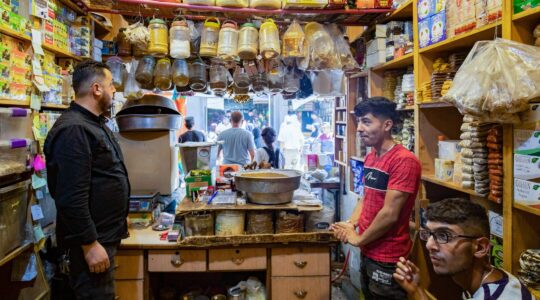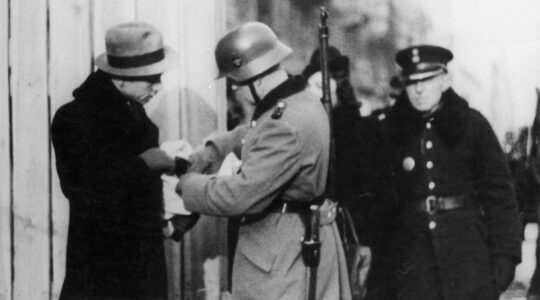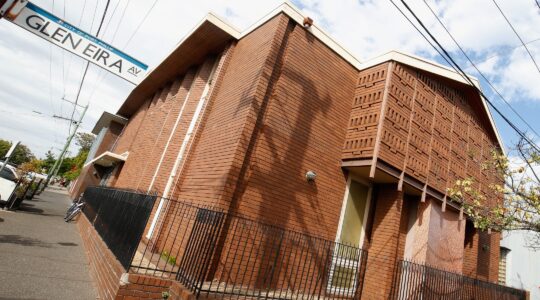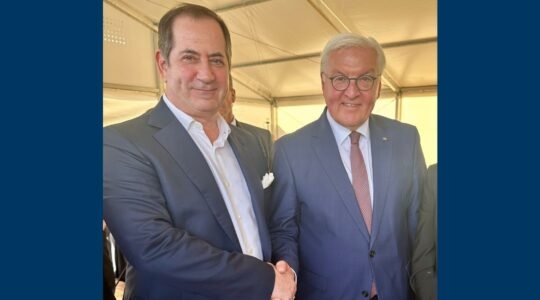
The lower part of the Schindler factory next to a demolished 19th-century building. (Lubomir Zmelik)
BRNENEC, Czech Republic (JTA) — The windows are smashed, the doors stand agape and the keys in the rusting padlocks have not been turned for years. Still, despite the plaster clinging to the crumbling bricks in leprous sheets, the front looks salvageable.
The back, however, tells a different story. Piles of debris block gaping holes knocked through the walls when the owners tore out the big textile machines. Nearby, the erstwhile camp hospital decays in a sodden mess.
This is the place where in the waning days of World War II, Oskar Schindler saved 1,200 Jews from near-certain death.
The Schindler buildings were last used by a company called Vitka, a once-thriving textile manufacturer. But after Vitka went into bankruptcy in 2004, a series of corporations sold off its machines for lump iron and stripped the buildings of anything of value.
In the course of last year, the latest owner of the property, Blue Fields, razed 80 percent of the factory buildings. Blue Fields also failed to pay the bank, which put a lien on the property. The bankruptcy administrator immediately put a halt to further demolitions, and the entire property, including the Schindler buildings, is now mired in litigation that could take years to resolve.
“Those buildings are going to stand there in that condition for years to come,” said the bankruptcy administrator, Jiri Krejcerik. “No one is going to invest into property that isn’t theirs.”
Blahoslav Kaspar, the mayor of Brnenec, the town where the factory stands, long has dreamed of turning the Schindler buildings into a Holocaust memorial. The town submitted a plan for the center to the regional authorities with a request for about $1 million. But it has no chance of acquiring the funds until the ownership issues are resolved.
Horrified by the rapid destruction, historical preservationists scrambled to have the site declared a national monument. But the request, now pending in the Czech Culture Ministry, hinges upon the concurrence of Blue Fields, which has stopped communicating except via an electronic mailbox. Until a company representative re-emerges, the authorities say their hands are tied.
Though a preliminary ban on demolition has been placed on all buildings, Blue Fields still destroyed several 19th-century buildings in better shape earlier this year, Eliska Rackova of the Pardubice Historical Authority told JTA.
“The owner produced a statement from the construction authorities saying that the buildings were decrepit and a danger to the public, and we were powerless to stop it,” she said.
Now there is concern that the same fate awaits the rest of the Schindler buildings, possibly condemning a key piece of Jewish history to the dustbin.
In the winter of 1944, as the war neared its end and the Nazis rushed to destroy concentration camps and prisoners, Schindler moved some 1,200 Jews from his enamelware factory in Krakow, where they faced near-certain death in Auschwitz, to Brnenec in the Czech Sudetenland.
At the time, Brnenec resident Eduard Kubin was a 17-year-old worker at a munitions plant adjacent to the Schindler buildings. Kubin, now 86, still remembers the freezing winter night when the transport arrived.
“It was the coldest winter anyone could remember, and 15 prisoners froze to death on the way,” he recalled. “They took them to the cemetery in the village of Brezova, but the priest wouldn’t let them be buried on cemetery ground. They had to dump them in a nearby hollow and pile old wreaths on them.
“After the war, the Czechs made the local Germans dig them up with their bare hands and place them in a mass grave inside the cemetery. Schindler even brought in a rabbi to consecrate the ground.”
Relics of those cruel times are everywhere: the latticework balcony where the guards took their smoke breaks; the courtyard where prisoners assembled; the iron gate with the peephole that still creaks open to grant a glimpse of the world; the low door (now marked with a sloppily painted D) that Schindler would emerge from for the review.
“Around back there’s a window where we used to leave loaves of bread,” said Kubin, pointing to a narrow alley next to the factory wall. “It was next to the electrified fence, in a spot where the guards in the towers couldn’t see. We’d wrap them in oily rags to camouflage them.”
“Giving them food was tricky,” said Petr Henzl, 83, whose father worked at the factory during the war. “A lady who lived behind the wall threw them some fruit once, but the guards caught them picking it up and gave them an awful beating.”
Both Henzl and Kubin give much of the credit for the survival of the prisoners to Schindler’s wife, Emilie.
“He was off on business mostly,” Kubin said. “She ran the kitchen and the hospital and got the headman at the mill to give them the leftover groats and husks to make gruel. She was also the one who took in the last transport in December.”
The few local residents who remember that time now look on in frustration as the property falls into further and further disrepair.
JTA’s efforts to contact Blue Fields, which does not list telephone or email contacts, were unsuccessful.
The Czech Jewish community says it would welcome a memorial in Brnenec.
“It’s a world-famous site, and it would be a shame not to use it for educational purposes — there can never be enough of those,” said Tomas Kraus, spokesman for the Federation of Jewish Communities. “In the history of the Czech Jews it is but one stone in the mosaic, but a very important one.”
JTA has documented Jewish history in real-time for over a century. Keep our journalism strong by joining us in supporting independent, award-winning reporting.





